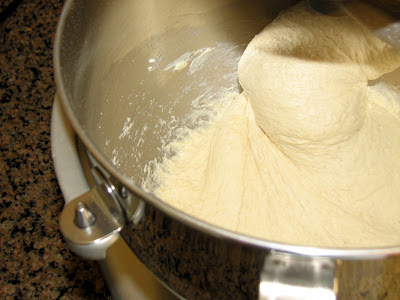
I found new bread blog via Rose's web site--it's called breadcetera.com, and the owner, SteveB, describes it as "an obsessive's quest for for professional quality baked goods from a home kitchen." I would say that's a pretty accurate description. He blogs only about once a month, but when he does, he shows a bread that he's worked up to perfection. I was more attracted to other breads on his site, but I opted to try the white whole wheat sandwich bread because I realized that, although I'd tried other whole wheat breads, I hadn't yet tried one made with white whole wheat. I've been disappointed with other breads made with white whole wheat, but I was willing to give it a try. I'm sorry to report that I was disappointed with this one too, but the friend I gave the other loaf to liked it quite a lot, so I may just have an errant taste bud that makes me taste bitter when I taste whole wheat.

I was excited about this recipe because it started out with a poolish, and I know how much flavor that overnight fermentation usually adds to bread. Also, it had honey, butter, and dried milk--all of which should amp up both the flavor and the texture.

Another thing that made this recipe different from most other bread recipes is that the initial mixing was done with the whisk attachment. I was curious to see what, if any, difference this might make in the final outcome--maybe it would make the dough a little fluffier, the texture a little lighter? Or maybe not. I couldn't tell any difference in the outcome. Finally, this bread uses the double flour addition method, which is pretty much what it sounds like--the flour mixture is added in two separate installments. I was psyched! I was sure this was going to be the best whole wheat bread ever--better even than Chris in R.I.'s whole wheat bread, my (so far) all-time whole-wheat favorite.

It was a lovely dough to handle, with enough butter to give it a very rich feel. It rose nicely (although the color is a little sludgy), making easily enough dough for two standard-sized loaf pans.

SteveB writes his own recipes, and even includes helpful videos for trickier parts of the process, like braiding or shaping. His recipes are all written in the passive voice, which seems somewhat odd and disembodied, and also a little irritating to a former English major. (Instead of saying, "Place the dough in a covered container," for example, he writes, "The dough is placed in a covered container.") Maybe he just doesn't want to sound bossy.

The bread came out of the oven looking brown and beautiful--not sludgy at all--and I anticipated the first slice. It was supposed to have a "satisfying deep wheaty flavor," according to SteveB. But it just tasted bitter to me. Jim liked it (although when I pressed him, he admitted he didn't love it), and my friend who got the second loaf said she liked it.
I intend to try more breads from Breadcetera, but they won't be made with white whole wheat flour. In fact, in a fit of pique, I threw out the rest of the bag. Although I'm not exactly giving this a rave review, I wish someone else would try it and let me know what they think because I'd like to know if it's just me.




